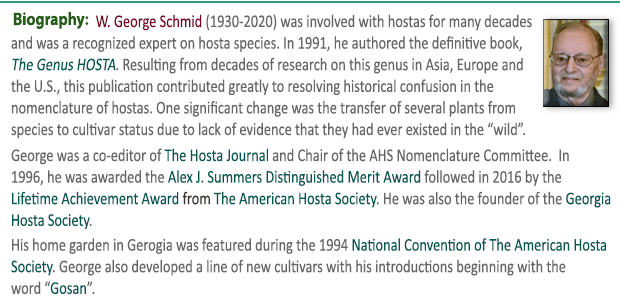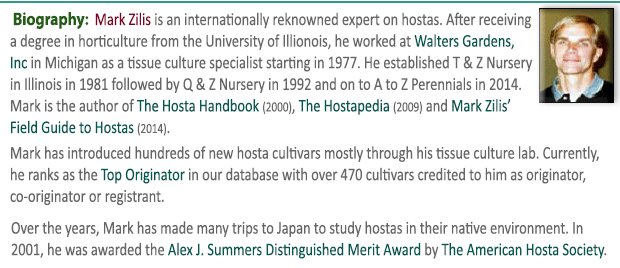|
  This
Korean species which was first identified in
1930, is noted for its bright purple
flower buds which appear in August but do not open. It is rhizomatous in nature
and spreads well, forming medium size (19 inches high by 45
inches wide) mounds. The
foliage is lance shaped, one inch wide and dark green, shiny on
top with a
sharp pointed tip. Flower scapes carry many dark purple buds and are purple
dotted near the base. This is triploid hosta does not set seeds
but the pollen is fertile. This
Korean species which was first identified in
1930, is noted for its bright purple
flower buds which appear in August but do not open. It is rhizomatous in nature
and spreads well, forming medium size (19 inches high by 45
inches wide) mounds. The
foliage is lance shaped, one inch wide and dark green, shiny on
top with a
sharp pointed tip. Flower scapes carry many dark purple buds and are purple
dotted near the base. This is triploid hosta does not set seeds
but the pollen is fertile.
 "Growing along river banks it is
exposed to periodic flooding brought about by typhoons during
the time of flowering and seed maturation which severely
disturbs normal sexual propagation resulting in evolutionary
changes to a more efficient vegetative method by way of
extensively creeping rhizomes." according to
The Genus Hosta by W. George Schmid (1991)." The species epithet is derived from clausus
= closed (bud)." "Growing along river banks it is
exposed to periodic flooding brought about by typhoons during
the time of flowering and seed maturation which severely
disturbs normal sexual propagation resulting in evolutionary
changes to a more efficient vegetative method by way of
extensively creeping rhizomes." according to
The Genus Hosta by W. George Schmid (1991)." The species epithet is derived from clausus
= closed (bud)."
H. clausa 'Normalis',
according to The Hosta Handbook by Mark Zilis (2000), is the "...same as the species, except that the flowers
open normally...".
From the
Field Guide to Hostas by Mark Zilis (2014), "Even if the flowers are artificially opened and pollinated,
they do not form pods...its rhizomatous nature makes it a
premier ground cover.
Mikiko Lockwood in an article on The Hosta Library titled,
A Little About Japanese Hosta Terms defines the term tsubomi as flower bud.



|



